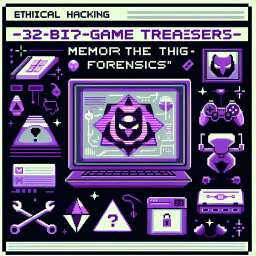
Memory Forensics
Start the machine, hack the system, and find the hidden flags to complete this challenge and earn points!
Start Your Challenge
This solution is for Flags Mode
This walkthrough explains how to hack the lab and capture the flags. For help with Learning Mode questions, use the Request Hint button next to each question.
Detailed Solution
Step 1: Understanding Memory Forensics
Memory forensics is the analysis of volatile memory (RAM) to find evidence of malicious activity, hidden data, or system artifacts. This technique is crucial in incident response and digital forensics.
Step 2: Initial Analysis
Start by examining the memory dump file:
- File size: 32MB (realistic for a memory dump)
- Contains structured data sections
- Includes realistic memory artifacts
Step 3: Using Analysis Tools
Several tools are available for analysis:
- strings - Extract readable strings from binary files
- hexdump/xxd - View file contents in hexadecimal
- grep/pcregrep - Pattern matching and searching
- binwalk - Binary analysis and file carving
- volatility3 - Professional memory forensics framework
Step 4: Searching for the Flag
The flag is a UUID format and appears multiple times in different contexts. Use these commands:
# Search for UUID patterns
strings memory_dump.raw | grep -E '[a-f0-9]{8}-[a-f0-9]{4}-[a-f0-9]{4}-[a-f0-9]{4}-[a-f0-9]{12}'
# Search for flag-related keywords
strings memory_dump.raw | grep -i flag
# Use pcregrep for more advanced pattern matching
pcregrep -a '[a-f0-9]{8}-[a-f0-9]{4}-[a-f0-9]{4}-[a-f0-9]{4}-[a-f0-9]{12}' memory_dump.rawStep 5: Finding the Encoded Flag
The flag appears in multiple locations within the memory dump, but it's encoded using ROT13:
- Deleted File Content - At offset 0x50000
- Process Memory Region - At offset 0x60000
- Network Packet Data - At offset 0x70000
- Registry Value Data - At offset 0x80000
Each location contains the same ROT13 encoded flag: s38sopp3-4076-4r14-n970-4857qsrn5op1
Step 6: Decoding the Flag
The flag is encoded using ROT13 (rotate by 13 positions). To decode it:
# Using Python import codecs encoded_flag = 's38sopp3-4076-4r14-n970-4857qsrn5op1' decoded_flag = codecs.decode(encoded_flag, 'rot13') print(decoded_flag) # Output: f38fbcc3-4076-4e14-a970-4857dfea5bc1 # Using online ROT13 decoder # Or using command line tools like tr
Step 7: Understanding ROT13 Encoding
ROT13 is a simple substitution cipher that replaces each letter with the letter 13 positions after it in the alphabet:
- a → n, b → o, c → p, ..., m → z
- n → a, o → b, p → c, ..., z → m
- Numbers and special characters remain unchanged
In our case:
s38sopp3-4076-4r14-n970-4857qsrn5op1
↓ (ROT13 decode)
f38fbcc3-4076-4e14-a970-4857dfea5bc1
Step 8: Understanding Memory Structures
The memory dump contains realistic structures:
- Process List - Simulated process information
- Network Connections - Fake network activity
- File Handles - Opened file information
- Registry Hives - Windows registry data
- Memory Artifacts - DLL names, command lines, environment variables
Step 9: Real-World Applications
Memory forensics is used in:
- Incident Response - Analyzing compromised systems
- Malware Analysis - Understanding malicious behavior
- Digital Forensics - Evidence collection and analysis
- Threat Hunting - Proactive security monitoring
- Compliance - Meeting regulatory requirements
Step 10: Advanced Techniques
Professional memory forensics involves:
- Process Analysis - Examining running processes and their memory
- Network Analysis - Finding network connections and data
- File System Analysis - Recovering deleted files and artifacts
- Registry Analysis - Examining Windows registry data
- Timeline Analysis - Creating chronological event sequences
Flag
The flag is: f38fbcc3-4076-4e14-a970-4857dfea5bc1
Learning Objectives
This challenge teaches:
- Memory forensics fundamentals
- Binary file analysis techniques
- Pattern recognition in large datasets
- Use of professional forensics tools
- Understanding memory structures
- Real-world incident response scenarios
- Digital forensics methodologies
- Basic cryptography (ROT13 encoding)
- Data encoding and decoding techniques